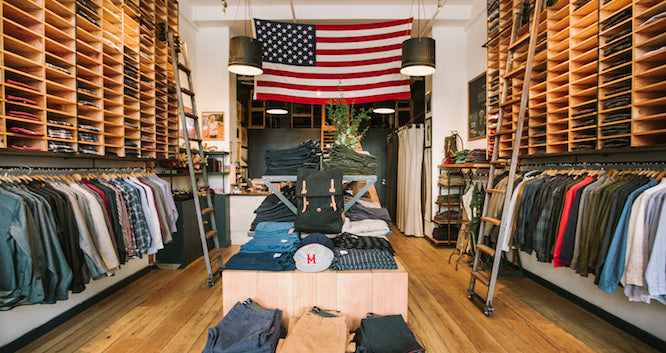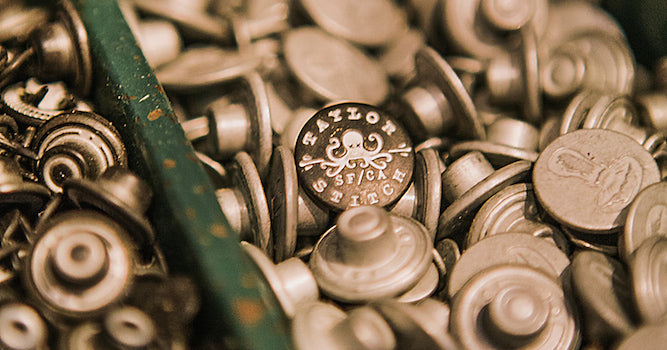Upon graduation, Michael Armenta, Barrett Purdum and Michael Maher wanted to start a business. They wanted to be part of the resurgence in American manufacturing and they wanted to create a fitted custom shirt.
After recognizing that custom tailoring was primarily the domain of 60-year old wealthy men walking around with their noticeable bellies, they saw a market opportunity for a slimmer, tailored, button up shirt for those who cared about the quality and design of their clothes, and where they were manufactured.
Fast forward to them striking a partnership with a family business in America that manufactures custom shirts and you get the origin story of Taylor Stitch. A rapidly growing brand that now has multiple product lines and is on a mission to dominate both the online and physical retail arenas.
They opened for business online on Shopify in 2008, then added a retail location a year and half later which now also runs on Shopify's iPad POS system.
I had a chance to catch up with Michael to talk about how they did it and what advice he could offer to others looking to do the same.
1) Describe your business and products. What are you guys all about?
We are an independent outfitter selling both online and in our physical retail location based out of San Francisco that modernizes classic staples for men and women. The idea is to create great-fitting, well-constructed garments that are all very easy to wear. We have had great online growth including 42% just this past year.
2) What made you get into omni-channel retail with both an online and offline presence?
It allowed us to touch our customer's senses better. It allowed them to feel the product, smell the store and hear the music that was being played. We also believe that brick and mortar helps drive online sales. Customers can come in and get a feel for the brand and how things fit and are in turn more confident buying online.
Also, we felt that the custom shirting experience really had to be offline. Having a physical retail allowed us to have people come in, get measured, and then go through the whole store to find complementary products.
It's kind of something we've come to hold sacred as it keeps the full circle going because we know when you get people in the store they'll say something like, "Oh yeah, I bought some custom shirts, maybe I'll get some jeans, and maybe grab some socks and a bag too."
3) How do you decide on what products to carry?

As a company we continue to carry more and more of our own stuff. However, we do carry some third-party products. For instance, right now we carry third-party socks because it doesn't make sense for us to manufacture our line of socks due to costs. The same goes for some jackets that are just too expensive, we don't want to have to make them on our own
4) How did you go about finding a location for your retail store?
We were lucky enough to open next to our friends at Four Barrel Coffee. We like to think that people who like to get coffee generally like good clothes. They're also the people who care about the products they consume and how they're designed.
So in general, we are big believers in opening next to consumables. For example, Four Barrel Coffee has amazing traffic and we are lucky enough to get some of that to run with and then working closely with them to build a strong local community. That community also includes the likes of Farnsworth, which is a modern furniture store and he has beautiful and really cool stuff.
The other benefit of being surrounded by like-minded shops is that people don't just want to travel a given distance to go to one particular store, they want to go to a shopping area, because people are shopping for the sake of shopping. For example, they might go to us because they want something like a custom shirt or because they want something they saw online and want to try on. At the same time they also want to go check out the other stores surrounding us. So you're really just driving traffic to a community, not necessarily just your store.
5) You started an online store first, how did you go about translating the "Taylor Stitch" brand into a retail location?

The key here is consistency and remembering that your online store and your retail store are not the same thing. In fact, a lot of people go from having a store to selling online because the physical manifestation of a brand is so much more deeper. For instance, you really can't look at a website and understand what the store is going to be like for the most part, there's no smell to a website, there's no feel to a website.
With that we still wanted to keep the look and feel of the brand. They needed to be an extension of each other so we started asking ourselves what type of wood we should use and making sure the same color palettes that came from the website were implemented.
The merchandising was all about approachability. We feel like too many physical stores are either too packed in or too sparse. It really is a delicate balance and we feel we achieve it pretty well.
6) How do you approach hiring and training personnel working in the store?
A lot of time we're lucky to find people who love our brand, and they really enjoy being a part of it and working with it. Obviously, they need to possess a given level of intelligence and care for the customer. And those are kind of the big things that I look for when we hire people.
They really have to want to be a part of this, but at the end of the day finding quality people is not rocket science. We've found that there's a humanness to everyone that works here at Taylor Stitch. There's no robotics in customer service here, where we have to teach people how to walk and talk when approaching customers. I just make sure they can walk up to somebody and hold a conversation.
7) What's your marketing or promotion strategy for the physical retail store?
The great thing about having a good location is the marketing is done already. People walk by and check things out. They like the product and they spread the word. We already had a pretty solid following locally so it really just allowed us to take that offline and show people what it was like to take part in our brand at the physical retail level.
But in regards to a generic marketing or promotion strategy, we don't have one. My goal is to set up in a place where people walk by and we just deliver a great product and great experience and that does enough.
I also don't believe in the word "sale." I think if the product's good enough, people buy it. For us sales are more of a thank you. There are promotions that we do throughout the year, it's more of a thank you to our customers for being a part of the brand and for loving the products.
Lastly, a big incentive for people to visit us both online and offline is that every week we launch new products. We send one email a week, but it's a comprehensive overview of what's happening with Taylor Stitch.
8) How do you manage the inventory or supply side of your business and decide how many and which products to stock?

We make a small amount of things to start and if it works well we keep bringing it back. It keeps our customers guessing and it allows us to test new things over and over before bringing them into the core offerings.
With inventory management, having all the inventory tied together in one place allows us to sell through product a lot better, because what we're able to do is look at product and realize that we don't have to worry about it sitting there because the web site will have sold a certain amount, and then the store also pitches in. There's no real separation making it a very fluid process. We also don't have to do a stock transfer here when the store's out or the website's out. It's fine if it's sold out in the warehouse, because there must be one in the store, and we just have to call the store to pull it before it goes and vice versa.
9) What other key advice can you offer ecommerce entrepreneurs looking to successfully transition into physical retail?
Speaking from our own experience, I would have opened a shop sooner if I knew and we had the capital. I mean pop-ups are great but in my opinion, if you have the capital you should just go open a store because pop-ups take just as much work to open a new store for the most part, especially with retail.
So my thought process is that you should just go open a store. But make sure you go find a place that works. Find a location that has great foot traffic. It's worth paying higher rent for foot traffic. You will quickly make up for it in sales. There are certain things I would definitely look for, like having a consumable around.
The other thing to remember is patience. You're not going to open and store and be doing a $100K a month in sales. Speaking from our own experience, we were so undercapitalized that we kind of had to piecemeal it together. But that was also the beauty of it, the fact that we were able to hustle and build it up ourselves by figuring it out and making it happen.
(Image Credits: Matt Edge)
